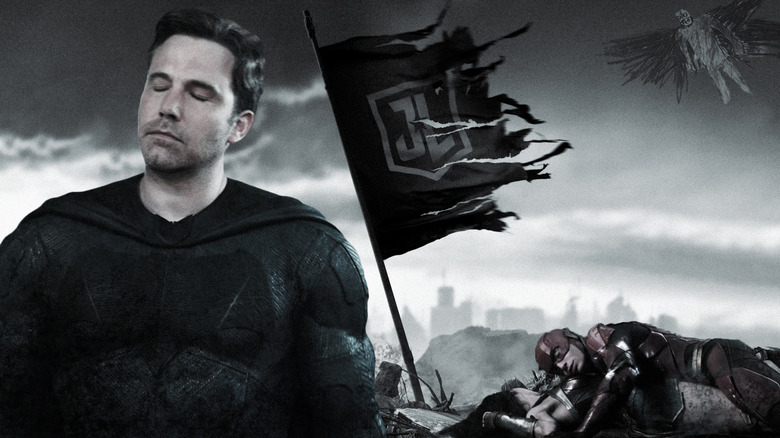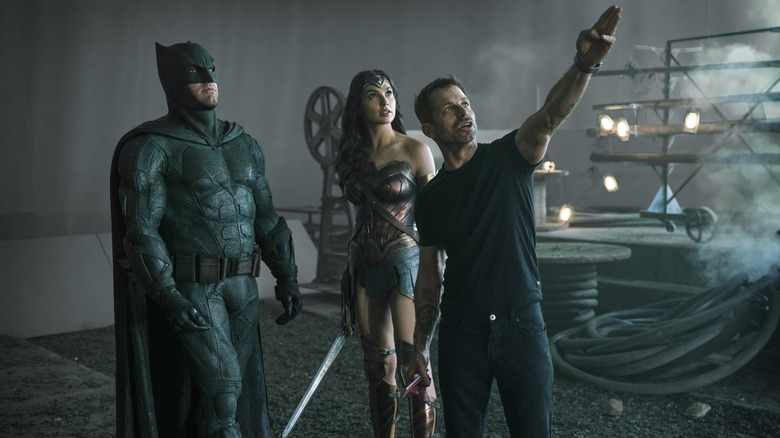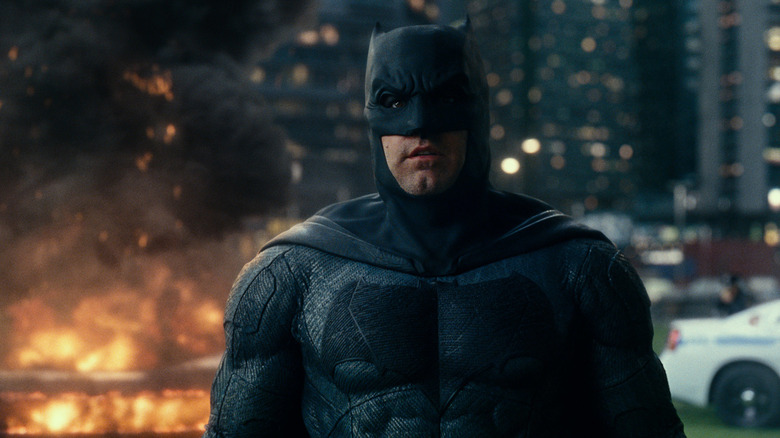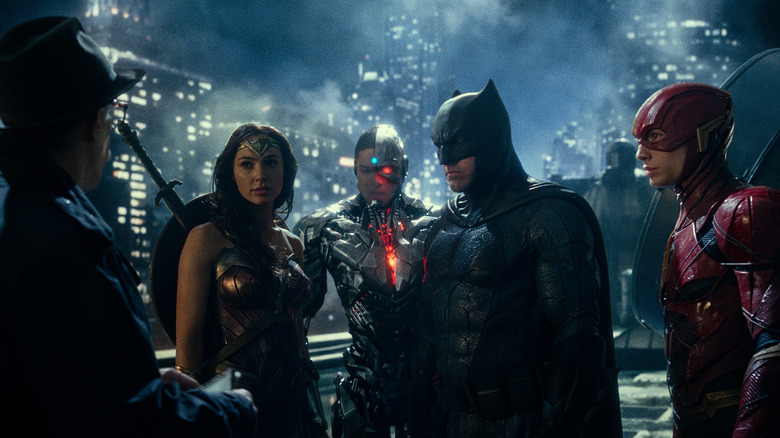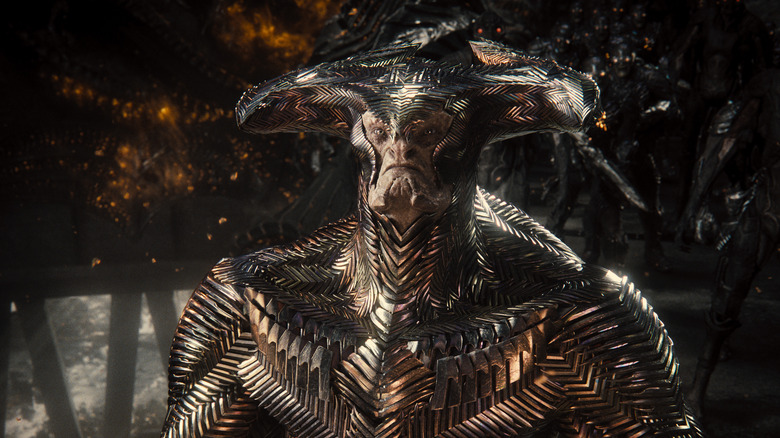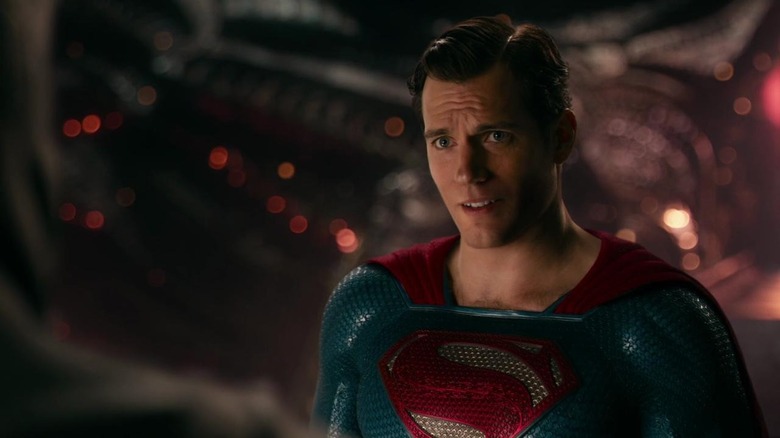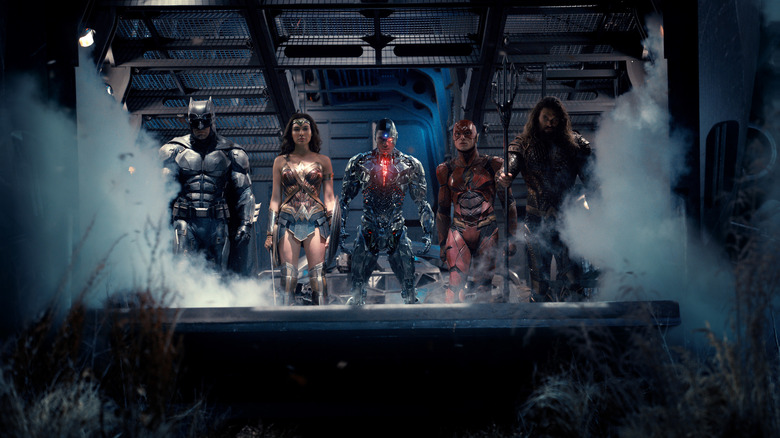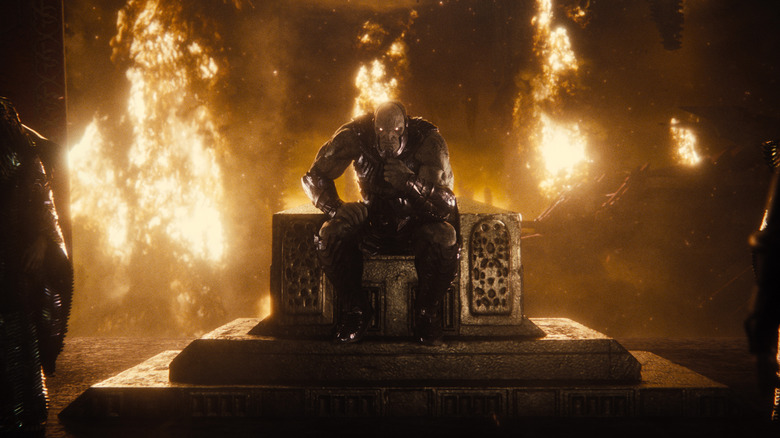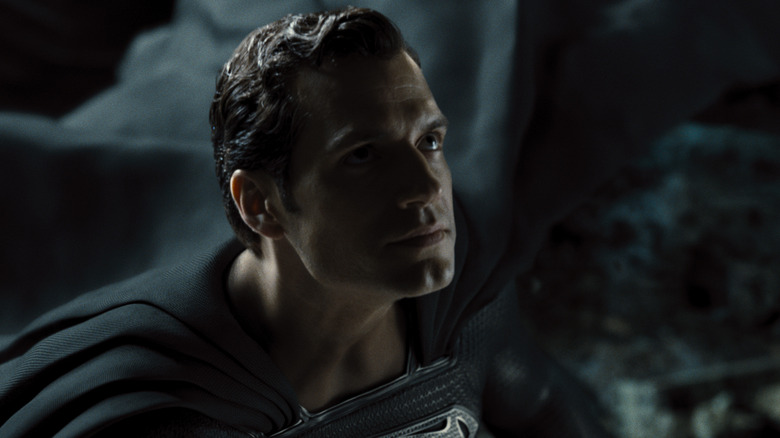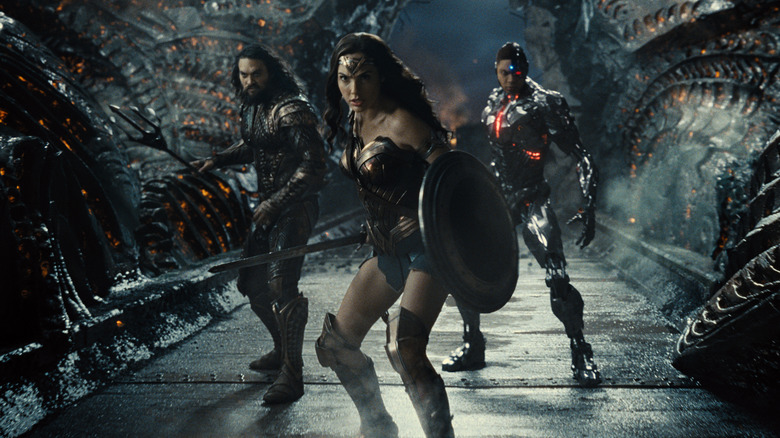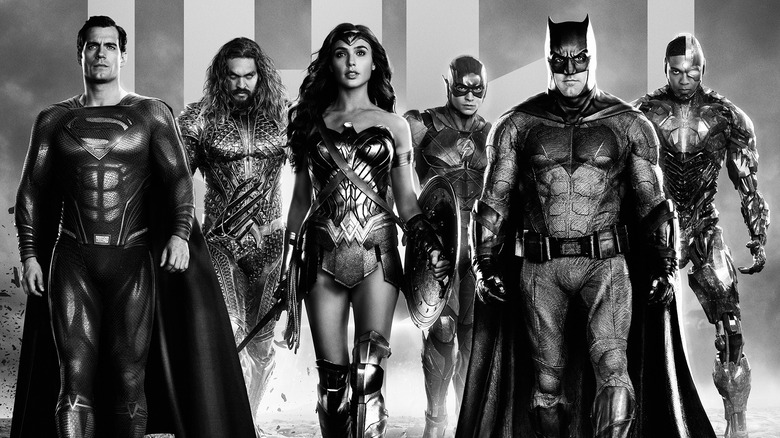Justice League: The Box Office Disaster That Doomed The DCEU
(Welcome to Tales from the Box Office, our column that examines box office miracles, disasters, and everything in between, as well as what we can learn from them.)
"That was the worst experience I've ever seen in a business which is full of some s**** experiences. It broke my heart," Ben Affleck said last year of his experience making 2017's "Justice League." Affleck went through the wringer when he was announced as our next Batman before donning the cape and cowl in 2016's "Batman v Superman: Dawn of Justice." And yet, for all of the vitriol and for all of the critical bashing of that film, it was Zack Snyder's follow-up that would break Affleck's spirit. What went wrong? Just about everything, it seems.
From Warner Bros. being determined to launch a DC cinematic universe capable of competing with Marvel's, to the studio becoming trepidatious about Snyder's vision for the so-called DC Extended Universe (DCEU), this film's production was legendarily messy — and tremendously expensive. It was a costly flop that the DCEU never really recovered from. Now, with the release of "Aquaman and the Lost Kingdom" in the rearview mirror, the DCEU is officially dead. Instead, it's now up to James Gunn and Peter Safran to reboot the DC Universe in the hopes of making something less messy than the Snyderverse.
In this week's Tales from the Box Office, we're saying goodbye to the DCEU. It's time to look back at "Justice League," how Warner Bros. originally seemed very confident in Snyder's vision, what happened when that confidence was shattered, how Joss Whedon tried to save the film with expensive reshoots, how the studio eventually circled back to Snyder anyway, and what lessons we can learn from the whole thing several years removed. Let's dig in, shall we?
The movie: Justice League
It's worth saying before really getting into this one that the story of "Justice League" (and really DC around this time) is worthy of a book, and probably not a small book. So this is, in some ways, only going to scratch the surface, but we're still going to try and paint a picture. To do that, we have to go back to early 2016. At that time, Warner Bros. seemed to have a lot of confidence in "Batman v Superman." Moreover, they had confidence in Snyder to execute his broader vision for the DCEU. That film included Gal Gadot's Wonder Woman in a major role, as well as cameos by Ray Fisher's Cyborg, Ezra Miller's Flash, and Jason Momoa's Aquaman, setting the stage for the future.
At one point, Warner Bros. even had "Justice League Part Two" on the calendar for June 14, 2019. "We're only ever planning and we are only doing 'Justice League,' just 'Justice League.' One movie," producer Deborah Snyder said in June 2016. Be that as it may, the studio was all-in on Snyder. So much so that the production of "Justice League" began in April 2016, just a couple of weeks after "BvS" opened in theaters. Rather crucially, the majority of critics were not in favor of Snyder's follow-up to "Man of Steel," with audiences starkly divided. And, in fairness, Snyder and WB had several battles behind the scenes when it came to that movie.
Negative feedback and slightly lower-than-expected box office weren't going to help the marriage between Snyder and Warner Bros. when the filmmaker began making an even more expensive movie that had much more riding on it. If "Justice League" didn't work, the future of DC's entire cinematic universe could potentially be in jeopardy. Yet, it's important to understand that Snyder didn't originally sign on to launch an entire universe; he signed on to complete a five or six-movie arc centered on Henry Cavill's Superman.
Zack Snyder's original DC plan
"Man of Steel" was essentially a standalone film. Snyder and Warner Bros. could have gone any number of ways after that movie made $668 million worldwide. Maybe that should have been something more akin to "Man of Steel 2." Instead, they decided to bring in a new Batman just a couple of years after Christian Bale concluded his run in "The Dark Knight Rises" for a big team-up film. Even so, this was not meant (at least so far as Snyder's original vision was concerned) to start a whole universe.
Neil Daly, a freelance market research analyst and focus group moderator who had a non-exclusive contract with Warner Bros. and New Line Cinema during Snyder's time at DC, explained on the "Fire & Water" podcast in January 2019 what the filmmaker originally had in mind. The way Daly tells it, he came on board around midway through the production of "Justice League" and revealed the arc Snyder had laid out before things got away from him.
"Snyder's overall plan was a five or six-movie arc. It was gonna be 'Man of Steel,' 'Batman v Superman,' 'Justice League,' 'Man of Steel 2,' and then a two-part 'Justice League 2' and '3,' essentially, was where they were going to go. It was more or less supposed to tell the arc of Superman."
Storyboard artist Jay Oliva also backed this up several years after the theatrical version of the film was released. "Yeah I mean I think that was the plan was that they would do like the four or five parters and then we would do a Flashpoint kind of reboot, where you can bring in a new cast afterward," Oliva said during Justice Con in 2021. Yes, Warner Bros. did try to make "The Flash" movie into a "Flashpoint" adaptation but that movie had its own, long, troubled road before it finally arrived last year only to disappoint greatly against sky-high expectations.
Tensions rise between WB and Snyder
The timeline is a little messy but tensions began to rise between Snyder and the studio as production rolled on. There were various disagreements. The director had a plan for the movie he wanted to make, and that plan was largely in place before "BvS" hit theaters. Meanwhile, Warner Bros. was very much trying to respond to the feedback they were getting from that film. Things got messy.
"I said that I would quit if they tried to take [the scene with Green Lantern] out," Snyder explained to Esquire in March 2021 pulling the curtain back on one such point of contention. The filmmaker originally planned to have a scene with John Stewart's Green Lantern, but WB wasn't having it. "I felt bad. The truth is I didn't want the fans to not have a movie, just based on that one stand that I was going to take," Snyder concluded. But that was just one of many little clashes that were pushing towards a sordid break-up.
In 2016, Warner Bros. was beginning to feel that the DC films were becoming too dark and violent. In response, comic book writer Geoff Johns and production executive Jon Berg were installed to oversee the DC movie slate to give it a more "optimistic" tone. They were tasked with a last-minute rewrite of "Justice League," done in conjunction with Snyder and screenwriter Chris Terrio. Then-Warner Bros. CEO Kevin Tsujihara also made it known that he wanted the film to be under two hours, per The Wall Street Journal in November 2017. Snyder's eventual director's cut was closer to four hours.
Tragedy strikes
In early 2017, a real-life tragedy paved the way for Snyder's exit from the director's chair. The filmmaker's adopted daughter died by suicide. Warner Bros. then announced that Joss Whedon ("The Avengers") would be brought in to finish the film in Snyder's stead. "I've decided to take a step back from the movie to be with my family, be with my kids, who really need me. They are all having a hard time. I'm having a hard time," Snyder said in May 2017 of walking away. Meanwhile, then-WB Pictures president Toby Emmerich seemed confident that Whedon could handle the task before him, saying the following at the time:
"The directing is minimal and it has to adhere to the style and tone and the template that Zack set. We're not introducing any new characters. It's the same characters in some new scenes. He's handing a baton to Joss but the course has really been set by Zack. I still believe that despite this tragedy, we'll still end up with a great movie."
While it's true that the tragedy spurred the filmmaker's decision to leave, it was not an easy one for him to make. "We just lost the will to fight that fight in a lot of ways," he said to Vanity Fair in February 2021. "All of us, the whole family, we're just so broken by [losing Autumn] that having those conversations in the middle of it really became ... I was like, 'Really?' Frankly I think we did the right thing because I think it would've been either incredibly belligerent or we just rolled over."
In the end, Warner Bros. took the opportunity to give Whedon a great deal of creative control, allowing the filmmaker who made "The Avengers" one of the highest-grossing movies of all time to try and lighten up "Justice League." It resulted in even more calamity.
Enter Joss Whedon
Whedon ended up doing weeks of reshoots and writing dozens of pages of additions to the script that he would Frankenstein together with some of Snyder's existing footage. Aside from adding untold millions to an already very expensive movie, it resulted in a bit of a mess. For one, Cavill was shooting "Mission: Impossible — Fallout" and had grown a mustache for the role. Warner Bros. had to pay to CGI the mustache off of his face during reshoots. The results left much to be desired. Sadly, that was just one problem that needed to be dealt with.
Gal Gadot and Ray Fisher had serious issues with Whedon, which they both made public. Those allegations cast a shadow over the already troubled production. "They asked me to fix it, and I thought I could help," Whedon said to Vulture in January 2022 about his work on the film. The article also states that he now sees his decision to work on the film as "one of the biggest regrets of his life." The movie that Whedon ended up putting together hardly resembled what Snyder intended. Speaking to Total Film in March 2021, Snyder explained:
"Because I've never seen the theatrical version of 'Justice League,' I don't know exactly what from my movie is in that movie. But I have heard from people who were on my crew and then continued on [with Whedon], there was about an hour of reshoots. So I guess they used about an hour of my footage, and they pretty much touched every shot, whether it was for ADR or whatever."
Warner Bros. was left with a big movie caught between two very different visions. Be that as it may, the studio was hellbent on meeting the November 17, 2017 release date no matter what. To make matters much, much worse, the budget ballooned to an absurd $300 million. At that point, success was more of a pipedream rather than a likely outcome.
The financial journey
Despite all the drama behind the scenes, "Justice League" did make its release date. It had a mostly clear runway as well, as Marvel's latest hit "Thor: Ragnarok" was entering its third weekend, while Lionsgate's "Wonder" didn't represent much by way of direct competition. Nor did Sony's animated feature "The Star." So yes, the massive DC team-up picture was going to easily top the box office on its opening weekend. But tepid reviews and a lot of negative press in the lead-up to the release paved a road that proved far too steep for Batman and the gang to climb.
The film (which was still credited to Snyder) opened to a respectable $93.8 million domestically. However, that was far less than "Batman v Superman," which opened to $166 million the previous year. DC's latest would surrender the crown to Pixar's "Coco" the following weekend. By the time "Star Wars: The Last Jedi" arrived a month later, the writing was on the wall and it was clear this was going to be a financial disaster for Warner Bros.
"Justice League" finished its theatrical run with $229 million domestically and $432.3 million internationally for a grand total of $661.3 million. It was the 14th biggest movie of 2017 overall behind WB's massive breakout horror hit "It," which made $700 million against a far smaller $35 million budget. "Wonder Woman" ($823 million) also made much more that year, as did Marvel's "Thor: Ragnarok" ($854 million), "Guardians of the Galaxy Vol. 2" ($863 million), and "Spider-Man: Homecoming" ($880 million).
The studio, conservatively, lost tens of millions on the release. The live-action debut of DC's beloved superhero team greatly disappointed the masses. But a certain subset of the fanbase was not content to just accept the situation for what it was. They would soon make their voices heard, extending the studio's headache for several more years.
The #ReleaseTheSnyderCut campaign begins
Almost immediately after "Justice League" hit theaters, vocal Zack Snyder fans began mobilizing online to convince Warner Bros. to release the filmmaker's original cut of the film. The hashtag #ReleaseTheSnyderCut would become a rallying cry for these fans, who were loud and relentless. Mind you, this was before it was even confirmed as to whether or not such a cut even existed. For the record, it didn't. An assembly cut was put together at one point but it was far from a finished film. Even so, the movement caught on like wildfire, dominating social media for weeks. Those weeks turned into months, and the months turned into years.
While many of these fans simply wanted to see a better version of the film, many others became downright toxic. Snyder may not have directly encouraged the toxicity, but he also embraced the movement, which made the whole thing quite messy. If there is one word that sums up this movie's journey, "messy" is probably it. The movement resulted in billboards, coordinated online campaigns, and the harassment of studio executives. It was unrelenting.
"I was watching it and I think I was crying all the way through," cinematographer Fabian Wagner said of watching Whedon's cut of the film in an August 2019 interview with Cinema Debate. The sentiment expressed by Wagner was not necessarily unique. "The 2017 theatrical cut was an act of vandalism. Zack may be too much of a gentleman to say that, but I'm not," writer Chris Terrio said to Vanity Fair in April 2021.
Those who worked with Snyder were loyal to him and many of them wanted to see his vision brought to life as well. This only further fueled the fire stoked by these rabid fans. Eventually, it became enough to get the brass at Warner Bros. to cave.
Warner Bros. finally caves to Zack Snyder's fans
In May 2020, following an online screening of "Man of Steel," Snyder confirmed that the so-called "Snyder Cut" would finally be completed and released. The heads of the studio planned to release the film as a four-hour epic that would stream exclusively on the HBO Max streaming service (now just called Max). The advent of streaming — which accelerated greatly during the pandemic — ultimately paved the way for the film to finally happen. It was presented, rather fittingly, as "Zack Snyder's Justice League."
But again, Snyder didn't have a completed film. To bring his vision to life would require lots more VFX work, as well as some more reshoots. Originally, this was said to cost around $30 million. Then-WarnerMedia chairman Bob Greenblatt, speaking to Vox in May 2020, revealed that it was going to cost much more than that.
"It isn't as easy as going into the vault and there's a Snyder Cut sitting there to put out. It does not exist. Zack is actually building it and it's complex including ... new VFX shots, it's a radical rethinking of that movie and it's complicated and wildly expensive ... I'll just say I wish it was just $30 million and stop there. It's an enormous undertaking and very complex."
The final budget was said to be around $70 million, which is more than the cost of the entire production for "Joker," a movie that ended up making more than $1 billion at the box office. Meanwhile, WB was investing a small fortune into a movie that had already lost a big fortune in its theatrical run. It probably didn't help that Snyder was dead-set against using a single frame of footage that was filmed by Whedon.
"There would be no chance on earth that I would use a shot that was made prior, er, after I left the movie. I'd destroy the movie, I would set it on fire before I would use a single frame that I did not photograph," Snyder said during a Justice Con panel in 2021. "That is a f***ing hard fact."
The Snyder cut arrives, the DCEU limps to the finish line
This was also just going to be a one-off, as the studio didn't have any desire to circle back to Snyder's vision for the DCEU. Then-WarnerMedia CEO Ann Sarnoff had this to say to Variety in March 2021.
"I appreciate that they love Zack's work and we are very thankful for his many contributions to DC. We're just so happy that he could bring his cut of the Justice League to life because that wasn't in the plan until about a year ago. With that comes the completion of his trilogy. We're very happy we've done this, but we're very excited about the plans we have for all the multi-dimensional DC characters that are being developed right now."
Released on March 18, 2021, "Zack Snyder's Justice League" was met with far more praise than the theatrical cut, even with its hulking runtime. Did it drive enough subscribers to HBO Max to justify the expense? Streaming is difficult to quantify but it's hard to imagine that being the case. The movie has also since been released on VOD and Blu-ray, which further helped the studio to capitalize on the investment. Still, we're talking about a movie that, all told, still lost money.
Even so, as WB tried to move on with the pieces of the DCEU that were still on the board, Snyder's fans continued to make their voices heard. Another hashtag, #RestoreTheSnyderverse, began showing up on social media. These same fans wanted to see Snyder finish his saga. This is despite the financial realities of the situation, and the fact that Affleck repeatedly said he was done playing Batman.
Things just kept getting messier. Not to mention that fans then began campaigning to get David Ayer's cut of "Suicide Squad" released as well. Rather than be happy Snyder's "Justice League" was completed and released, a vocal subset of fans wanted much, much more. They wouldn't get more. After "Shazam! Fury of the Gods," "The Flash," "Blue Beetle," and "Aquaman and the Lost Kingdom" disappointed at the box office last year, the DCEU came to an unceremonious end.
The lessons contained within
Everything that Snyder started is now a thing of the past. "Justice League" was, in so many ways, the beginning of that end. When DC's big superhero team failed to materialize and instead generated an unending online campaign demanding something different, there was no going back.
Warner Bros. didn't like what they had, but what they had was intrinsically tied to Snyder and his vision. That was a vision they didn't want to proceed with at some point, and the pivots that followed often felt like trying to fit a square peg into a round hole. The DCEU, right up to the end, felt like a universe with no cohesive direction. The success of standalone movies like "Joker" and "The Batman" only served to amplify that fact.
History will be examining the DCEU for years to come. What I am left with personally is the feeling that the studio should have probably followed through and let Snyder execute his vision, for better or worse. That's easy for me to say, sure, but it's hard to argue in favor of what happened. Rather than rush a cinematic universe that wasn't ready, they could have let Snyder at least get through "Justice League." After all, his version was better received and one imagines a theatrically releasable 2.5/3 hour version would have done better and cost less. At that point, let him proceed or cut it all off.
At the very least, WB wouldn't be anchored to a version of a sprawling universe they didn't necessarily want. They could have let the Snyderverse be one thing, and other DC projects be other things. While I'm not condoning the awful behavior demonstrated by many Snyder loyalists, I am suggesting that a version of the DC Universe that wasn't trying to cobble together a continuity from spare parts might have, in the long run, been better for everyone.
As it exits, "Justice League" stands alone as a singular cautionary as a worst-case scenario for franchise filmmaking.
